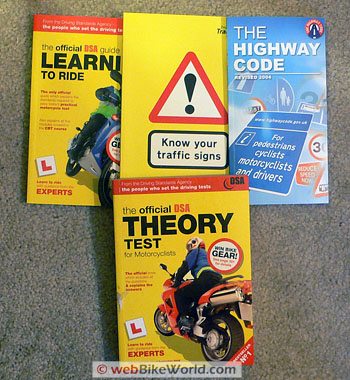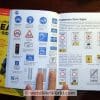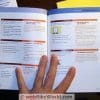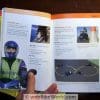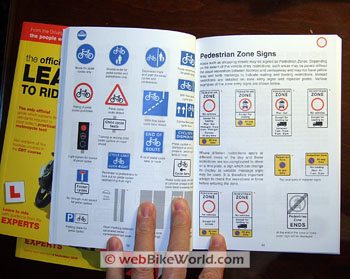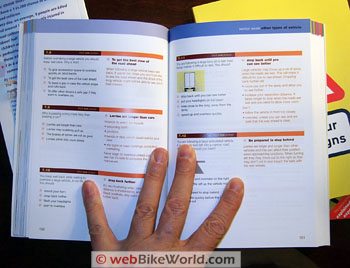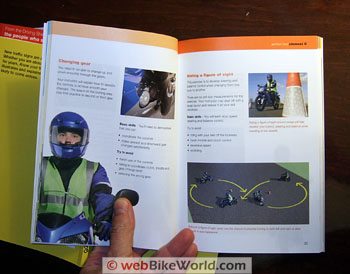ISBN-13: 978 011 552750 8
Published by the Driving Standards Agency, Sixth Edition, 2006
Cost: £11.99
The Official DSA Guide to Learning to Ride
ISBN-13: 978 011 552645 5
Published by the Driving Standards Agency, Fifth Edition, Second Impression, 2006
Cost: £7.99
Know Your Traffic Signs
ISBN: 0 11 551612 3
Published by the Department for Transport, First Published 1999, Fourteenth Impression, 2006
Cost: £3.50
The Highway Code
ISBN-13: 978 011 552698 5
Published by The Stationery Office, 2004
Cost: £1.99
I’ve been to England and Wales many times, but always without driving a car or piloting a motorbike.
I’m rather fascinated by trains, and although my British friends may heartily disagree, the national rail system in the UK is, I think, fantastic, at least compared to the limited system of rail travel in the U.S.
But I must admit that I often fantasize about driving a bike or a car on the English country roads, which would help me get to the out-of-the-way places that aren’t served by rail.
And since the British Pound is now running nearly two U.S. dollars, those long-distance cab rides from the train station to my destination are becoming very painful.
So what’s stopping me? Well, first of all, my fear of driving on the left I have never done it, even though others tell me it’s “a piece of cake” — once you get used to it, that is — but I just can’t get my mind wrapped around it and what to do in a city or in an emergency situation if I was driving on the left, sitting on the right and shifting with my left hand.
Maybe I’m wrong, but I think that riding a motorbike on the left would be easier for a first-time lefty? The bike’s controls are the same and I feel like I’d have more room to maneuver on the road. But maybe not — if anyone has some insight on this, please let me know (see the comments section at the end).
The other problem I have is with the strange (to me anyway) road signs It’s bad enough I’d be driving on the left and sitting on the right, but how about those signs? Like the squiggly things before a crosswalk? Or the narrow vertical white rectangles with red slashes on them? They come in blue and white too What’s the diff?
And how about those signs with a number in them like “30” and a red slash going from upper right to lower left? Let’s see: do they mean don’t go less than 30? Or don’t go more than 30? Or, maybe, do anything but 30?
I have another trip coming up soon, and all of a sudden I got the brilliant idea of doing some research to see if there were any materials that could help me learn about riding motorcycles and driving cars in the UK
Know Your Traffic Signs
I started out by looking for a simple road sign book and I found it: “Know Your Traffic Signs” is, I assume, a complete compendium of every road sign likely to be encountered on Her Majesty’s highways and byways. It’s published by the Stationery Office of the Department for Transport, which, I think, is responsible for developing and maintaining UK signage. So it should have the correct info, from the official source, right?
My thinking is that this book, basic though it is, will be useful for both riding and driving so I will know what those signs are telling me. It’s probably even more important on a bike to have instant recognition of road signs, because the stress levels will be high and my lack of experience will mean split-second decisions
The book is packed full of information and many color illustrations of all the UK road signs. Now all I have to do is basically memorize everything!
There are lots of photos, each with a basic description, but this is pretty dry reading — not something you’d want to study after drinking a glass of warm milk at 10:00 at night. You’d be out cold in a second, bored to tears.
But, it’s all there and it’s all useful. They even start off with the “History of Traffic Signs”, which is actually interesting and helps to lighten up what is otherwise a somber subject.
The rest of the chapters are organized by the sign type; e.g., Warning Signs, Speed Limit Signs, Pedestrian Zone Signs, Parking Signs, etc., which is helpful.
It took me a while to notice, but at the top of each page is a very small icon representing the type of sign that is described on that page. These make it easier to look up a sign if necessary.
So if you’re planning on either driving or riding in the UK, “Know Your Traffic Signs” is a must-have.
The Highway Code
And something that goes hand-in-glove with the sign book is “The Highway Code” It’s designed for pedestrians, cyclists, motorcyclists and drivers (note that they list them last!).
This book actually has most of the road signs but with even more abbreviated descriptions than “Know Your Traffic Signs”, but it’s real purpose is to describe all of the laws that must be obeyed for proper use of the road system, no matter what type of conveyance you’re on or in.
I’m surprised at how similar most of the road and driving laws are to those in the U.S I think a single reading or two of this book will suffice, but I do recommend it to make sure you know enough about the rules to (hopefully) stay out of trouble.
It also includes an “Annexes” in the back that have some important information on obtaining a motorcycle license (or licence, as they say); registering a vehicle and a description of penalties and points.
UPDATE: wBW visitor “P.C.” sent us a note to say that the Highway Code is also available online at this official UK government website (Thanks P.C.!)
OK, so far we’ve only spent £5.49 (about $10.00) and we know all about the road laws and signs. This, at a minimum, is recommended for anyone who will be taking their fate (and the fate of others) into their own hands by plunging in to UK traffic instead of riding the rails.
All of these books can be easily ordered from Amazon.co.uk and delivered to the U.S. for a nominal fee. webBikeWorld has purchased many books from the UK and the delivery times always seem faster than expected. So I see no reason to postpone a purchase of these books so you can read them before you go — perhaps on the plane?
The Official DSA Theory Test for Motorcyclists
But while I was at it, I became curious to know what it would take to get a UK motorcycle license — sorry, licence And, I thought maybe learning how they do it might also uncover some riding tips that I could use also.
So I discovered that the two books for beginning riders are “The Official DSA Guide to Learning to Ride” and “The Official DSA Theory Test for Motorcyclists”.
Now I certainly don’t profess to understand all of the intricacies of obtaining a UK motorcycle license, nor do I plan on getting one any time soon, but, like U.S. riders, they have to take a written test and a supervised riding test.
In the UK, the theory test, as of this writing, consists of two parts.
The first is a 35-question multiple choice exam (taken on a computer touch screen) and a hazard perception test, which shows a series of 14 videos, taken from the rider’s point of view
You must press the mouse button “as soon as you see a hazard developing that may result in you, the rider, having to take some action, such as changing speed or direction.”
There’s a 10-second delay after the video first appears to allow you to see the beginning of the new road situation. The hazard perception test takes 20 minutes and there’s no “do-overs”, because, they say, “you don’t get a second chance to see a hazard when you’re riding on the road.”
The Theory Test book format is lists of questions and their answers — I guess you need to know them all because you won’t know which ones they’ll pick. The questions include everything from road signs to rules of the road (two more reasons why you’ll need the books described above), motorway rules, motorcycle handling, safety margins, documents needed and more.
There are a few good gems in there, but not much new for experienced riders. While the Q&A format may sound boring, it’s still better than the help books I’ve seen in the Departments of Motor Vehicles in the U.S.
It would be very nice indeed if the individual U.S. State licensing agencies had a standardized book like this, because it does nearly include about every situation a rider or a driver might encounter on the road.
The Official DSA Guide to Learning to Ride
Which brings us to my favorite, “The Official DSA Guide to Learning to Ride”
Again, there is probably nothing in this book that will enlighten an experienced rider, but the format is very user friendly.
It has many big, colorful pictures, graphics and charts that provide a solid basis for motorcycle riding knowledge, no matter if it’s on the left or right side of the road.
Of course, the “Learning to Ride” book is definitely focused on UK laws and the standards required to pass the practical motorcycle test.
But I just think it’s good to learn what others are learning, because even if you only pick up a couple of tricks, it’s worthwhile.
Note that there are several other books available from either the UK Driving Standards Agency (DSA) or the Department for Transport, including “The Official Guide to Hazard Perception”, “The Official DSA Guide to Riding – The Essential Skills” and a video/book combination entitled “What If?”, subtitled “The Official Guide to Boosting Rider Awareness” (also a website) and an interactive DVD of the Hazard Perception book.
Other books, some of which have been reviewed on webBikeWorld, include “Pass Your Advanced Motorcycling Test” by The Institute of Advanced Motorists; “Motorcycle Roadcraft: The Police Rider’s Handbook“, which is an interesting description of the techniques used by UK’s highly skilled police riders.
Conclusion
If you’re planning on riding or driving in the UK, it would be useful, at the very least, to buy a copy of the “Know Your Traffic Signs” and “The Highway Code” I don’t think anyone, least of all UK citizens, want any of us to be let loose on their roads without a basic knowledge of how to behave.
I encourage our UK friends to add their comments, tips and suggestions on riding, driving and motorcycle licensing for the benefit of others (see below).
Master Listing of All wBW Motorcycle Product Reviews
wBW Rating: It’s rather hard to rate these books, but if you’re actually going to ride or drive in the UK, the “Traffic Signs” and “Highway Code” get 4 stars and the others get 2 stars for motorcyclists outside the UK and 4 stars for UK citizens.
Publication Date: June 2007
The wBW “Flaming Helmet” Book Review Rating System | Book Reviews Home | All Reviewed Books Ranked by Rating
Owner Comments and Feedback
See details on submitting comments.
From “C.H.” (06/2011): “I’ve just found your article about driving in the UK. Your approach seems to be eminently sensible because traffic density and speed can be quite frightening, especially if you are driving on the ‘wrong’ side.
We have one advantage in that it is relatively easy to take the train of ferry over to the Continent which gives us ready access to the EEC countries, all of who drive on the right.
There have been examples of accidents in the Dover area (an English Channel port) when drivers take the wrong side of the road by mistake even though there is traffic signage to guide. I don’t know how visitors can get driving permits here, since our British licences allow us to drive in France etc. (I would say that driving in France can be easy but the ones to look out for are the cars with British registration plates!).
There is nothing to prevent visitors from contacting a driving school (see Yellow Pages) and having a lesson or two to help with acclimatisation.
It would be worth stating whether an automatic transmission is required though. As I’ve driven a manual shift for over 40 years almost exclusively that’s something I might overlook (but well into retirement now I’m thinking about changing my car for something from the VW Group with their excellent DSG gearbox).
Here, we have the Institute of Advanced Motorists who are dedicated to improving driving standards and road safety. They cater for cars, motorcycles and commercial vehicles. There are many local branches, run by volunteers so if you are going to stay here for any length of time that would be a worthwhile move.
I would recommend that on the basis of being a very low cost that could quite easily save your life. Importantly, it raises awareness and observation skills which are of course transferable to the USA, Canada and indeed worldwide.
Oh, one more thing, please take extra care here when walking – we do drive on the wrong side so look both ways – twice!”
From “D.M.P.”: “A couple of thoughts following Nestor’s article on riding in the UK : Wherever you are going to ride or drive, reviewing the local road signs is critical – especially speed limits, and some of the more unusual highway signs Getting stuck in the “EZ-Pass equivalent” toll booth on an Italian Autostrada is embarrassing, but taking a fully loaded Honda Trans-Alp enduro tourer the wrong way down an alley in Florence is just stupid (and yes, I did both).
Switching from driving on the right to left side of the road or vice versa is really very simple, and I found it easier on a bike than a car The “equipment” is identical so all you have to worry about is the traffic, and actually the more traffic on the road the easier it is – you just follow what everyone else is doing ! The only times I’ve ever found myself on the wrong side is at 2am in a deserted parking lot, with no frames of reference.
Hardest part about the UK is “roundabouts” – traffic circles Not that common in the US, and can get confusing combined with the left hand driving I would suggest some time on 4 wheels before trying them on 2 Safe riding !”


